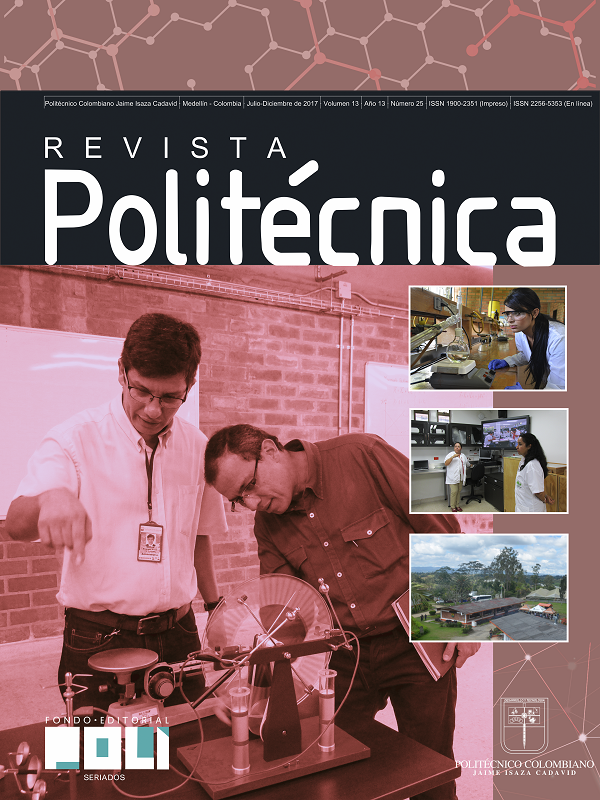Autonomous unmanned aircraft system for the geometrically irregular surfaces sampling: Fatigue analysis and design
DOI:
https://doi.org/10.33571/rpolitec.v13n25a10Keywords:
Design, quad copter, fatigue, transformation, samplingAbstract
Here is registered as a guide a quad-copter design procedure, which is framed on implement a new movement aircraft methodology. This new approach break the classical kinematic displacement approaches, giving the quad-copter the capacity of realize partial on-fly inclinations. This without affecting its global position, velocity or acceleration values. All above focused in improve the general multi-rotor abilities into the autonomous sampling process. Clearly related with the irregular surfaces analyse, usually seen on the precision farming or simply on natural environments. A division has suggested to expose the step by step design cycle of two crucial mechanisms, first a tubular T-form quadcopter arm and second a central transformation mechanism. Both provide the reader a greater understanding about a whole and extensive airship design process. Each of the around ten integrated pieces are completely organized, easily raised and also correctly justified fulfilling the three point eight general security factor.
Article Metrics
Abstract: 728 HTML: 110 PDF: 463 XML: 32PlumX metrics
References
V. G. Ambrosia and T. Zajkowski, “Selection of appropriate class uas/sensors to support fire monitoring: Experiences in the united states,” in Handbook of Unmanned Aerial Vehicles. Springer, 2015, pp. 2723– 2754.
K. Valavanis and G. Vachtsevanos, Handbook of Unmanned Aerial Vehicles, 2015. [Online]. Available: http://library.wur.nl/WebQuery/clc/2065964
H. Ryaciotaki-Boussalis and D. Guillaume, “Computational and experimental design of a fixed-wing uav,” in Handbook of Unmanned Aerial Vehicles. Springer, 2014, pp. 109–141.
S. Gruber, H. Kwon, C. Hager, R. Sharma, J. Yoder, and D. Pack, “Uav handbook: Payload design of small uavs,” in Handbook of Unmanned Aerial Vehicles. Springer, 2014, pp. 143–163.
J. Fang, Y. Gao, G. Sun, G. Zheng, and Q. Li, “Dynamic crashing behavior of new extrudable multi-cell tubes with a functionally graded thickness,” International Journal of Mechanical Sciences, vol. 103, pp. 63–73, 2015. [Online]. Available: http://linkinghub.elsevier.com/retrieve/pii/S0020740315003203
A. Khalifa, D. Weaver, and S. Ziada, “A single flexible tube in a rigid array as a model for fluidelastic instability in tube bundles,” Journal of Fluids and Structures, vol. 34, no. 0, pp. 14–32, 2012. [Online]. Available: http://www.sciencedirect.com/science/article/pii/S0889974612001387
S. K. Phang, K. Li, B. M. Chen, and T. H. Lee, “Systematic design methodology and construction of micro aerial quadrotor vehicles,” in Handbook of Unmanned Aerial Vehicles. Springer, 2014, pp. 181–206.
H. Duan and P. Li, Bio-inspired computation in unmanned aerial vehicles. Springer.
S. A. Brandt, “Small uav design development and sizing,” in Handbook of Unmanned Aerial Vehicles. Springer, 2015, pp. 165–180.
T. Wang, T. Zhao, H. Du, and M. Wang, “Transformable aerial vehicle,” Sep. 18 2014, uS Patent App. 14/167,679. [Online]. Available: http://www.google.com/patents/US20140263823
M. E. Fernández, “Efectos del cambio climático en el rendimiento de tres cultivos mediante el uso del Modelo AquaCrop,” Tech. Rep., 2013.
American Bureau of Shipping, ABS GUIDE FOR FATIGUE ASSESSMENT OF OFFSHORE STRUCTURES, 2014, vol. 2003, no. February.
M. F. Ashby and D. Cebon, “Materials selection in mechanical design,” Le Journal de Physique IV, vol. 3, no. C7, pp. C7–1, 1993.
T. Rayna and L. Striukova, “From rapid prototyping to home fabrication: How 3d printing is changing business model innovation,” Technological Forecasting and Social Change, vol. 102, pp. 214–224, 2016.
G. Wypych, “fABSg poly(acrylonitrile-co-butadiene-co-styrene),” in Handbook of Polymers, G. Wypych, Ed. Oxford: Elsevier, 2012, pp. 3 – 10. [Online]. Available: http://www.sciencedirect.com/science/article/pii/B9781895198478500047
Hyramis Edith Rosales Manrique, “METODOLOGÍA PARA EL ESTUDIO DEL COMPORTAMIENTO A FATIGA BAJO CARGA AXIAL DE MATERIALES POLÍMÉRICOS,”
Magíster en Ingeniería Mecánica, Universidad Simón Bolívar, 2006.
Dji, “DJI E800 Multirotor Propulsion System,” Tech. Rep., 2015. [Online]. Available: http://www.dji.com/product/e800
T. Barry N and T. Ambler, Eds., The International System of Units (SI). Gaithersburg: National Institute of Standards and Technology, 2008.
D. G. Ullman, The mechanical design process. McGraw-Hill Science/Engineering/Math, 2002.
R. L. Norton, “Machine design: an integrated approach, 1996.”
P. Hunt, F. N. Unterhauser, M. J. Strobel, and A. Weiler, “Development of a Perforated Biodegradable Interference Screw,” vol. 21, no. 3, pp. 258–265, 2005.
U. S. T, “Wear properties of niobium carbide coatings performed by pack method on AISI 1040 steel,” vol. 483, pp. 152–157, 2005.


 _
_






















